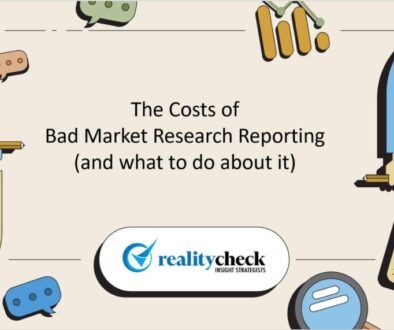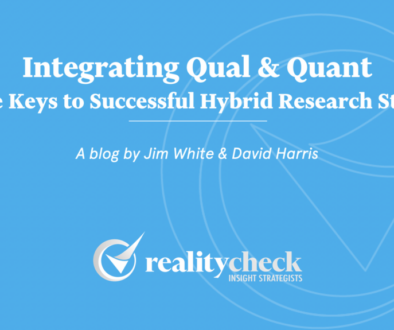Innovative Research Methods: How a Human Insights Approach Can Transform Routine Market Research
I used to have a boss in the market research business who would ask, “How do you get interesting insights?” To which he’d provide the answer “Ask interesting questions!”
One way to guarantee interesting questions in market research is to stop pursuing Consumer Insights and start pursuing Human Insights.
In recent blog posts, we’ve argued that Human Insights have huge advantages over Consumer Insights. One reason is that a human perspective — one that takes into account the life experiences and aspirational identity of the whole person — allows you to ask more interesting questions.
But how does a Human Insights approach change how we go about the routine marketing research projects we do all the time?
Here are three types of routine insights projects that we do frequently and how the shift from a consumer perspective to a human perspective affects each.
Understanding Segments:
From questions of consumption to questions of identity
We do a lot of work each year on segments. We conduct ethnographic and psychological deep dives to follow-up quantitative segmentation studies. Brand teams want to understand their segments on a “deeper level” so they can find “white space” for innovation and “core insights” to inspire messaging.
A Consumer Insights approach to these studies typically begins with a narrow focus on brands and consumption. Such projects explore people’s beliefs and attitudes about brands in the category and their shopping, purchase and brand usage behavior.
Such studies are limited from the outset because they start with a narrow focus on the consumer part of people, rather than a broad curiosity about what matters to the whole human being.
A Human Insights approach to segment analysis focuses on identity rather than consumption. A Human Insights approach to segments asks “Who do these people want to be?” Once we have a thorough understanding of this question, then (and only then) we ask, “How can our brand help them realize this aspirational identity?”
Human Insights tip: The next time you want to understand a segment, ask them to tell or write a story about two alternative futures for themselves — one positive and one negative. Then, after their stories are written, ask them to describe how your brand might help them achieve the positive future and avoid the negative one.
Optimizing Advertising/Packaging
From questions of evaluation to questions of association
Whether we like to admit it or not, people filter and deconstruct our ads and package designs and recreate them in their minds to serve their own purposes. If a creative message connects with someone, it is because they find it useful in helping them create their own personal story.
Most Consumer Insights approaches to creative development are evaluative. We often hear clients say they need to “test” creative, essentially asking “consumers” the question, “What do you think of this idea?” But this question doesn’t accurately represent how people process and use messaging. It also requires something of respondents they simply are not qualified to do (that is, evaluative advertising and design).
A Human Insights approach explores a profoundly different question. It asks, “What does this idea make you think of?” This is a question about the cognitive and emotional associations the idea evokes in people.
The difference between these two questions is immense. The latter question sends us on a journey to understand what, if anything, a creative message brings to mind from a person’s own life, experiences, memories and aspirations. People don’t care what the intended message of your advertising or packaging is. They only care how they can use it to help tell themselves a story about who they want to be. The creative messages that people want to incorporate into their own narrative identities is the message that is most relevant, meaningful and motivating.
Human Insights tip: The next time you’re doing qualitative research on advertising or package design, start by asking people, “What does this idea make you think of from your own life or experiences? What does it bring to mind for you? What memories does it trigger?” The ultimate measure of relevance is whether an ad or design connects with someone’s own life experience and aspirations in a meaningful way.
Decision Journey/Shopper Insights:
From questions of transaction to questions of context
Many Decision Journey and Shopper Insights studies are intensely transactional. They focus like a laser beam on those thoughts, feelings and actions related to shopping and buying. In doing so, they often misrepresent the process as being more conscious and linear than it really is.
A Human Insights approach recognizes that real-life decision making is often messy, irrational, nonlinear and nonconscious. It asks “What is the broader life context in which this decision takes place?” It explores the pressures, distractions and emotions that shape how decisions are made in real life. It considers the ways people hope to transform themselves and their lives through the shopping experience. And it considers the myriad ways people simplify decision-making to deal with the complexities of daily life.
Human Insights tip. The next time you do Shop Alongs, meet the respondent at their home first. Spend some time getting to know them — who they are and who they want to be. Get to know a little about their daily life before you go shopping. You’ll begin to understand a bit more about the real-life context in which the shopping journey takes place and how that human being might hope to be transformed — even if only momentarily — by the experience.
So there you have it. Three types of routine market research projects and how a Human Insights approach can make them more interesting. Let me know what you think. And please, share with me the ways you’ve applied a human perspective to the insights work you do!























